In transcribing the following article from the Hathi Trust online version of a copy of the Illustrated London News in the University of Chicago Library, I have used ABBYY software to produce the text below. I have added images of the ship from a later article in ILN and links to material in the Victorian Web — George P. Landow

Section of the Great Britain Steam-Ship. Click on images to enlarge them.
This stupendous steam-ship will be launched at Bristol on Wednesday next. She is of unparalleled v&stness, her actual tonnage being some hundreds of tons more than that of any ship ever built, which circumstance, conjoined with her peculiarities of material and construction, must render her completion an important event in the records of engineering and mechanical skill. We shall, therefore, proceed to describe this “mammoth” vessel as much in detail as our space will allow; and the reader who is anxious to estimate the importance of this new achievement in science will do well to make himself acquainted with the following leading constructive details, abridged from a very able description of the vessel, by Mr. J. R. Hill, C.E., in the “Year-book of Facts” for 1843, to the publisher of which useful work our acknowledgments are due for the loan of the accompanying explanatory outline engravings. We shall merely premise that the Great Britain is iron-built, and fitted with Mr. Smith's Archimedean screw-propeller instead of paddle-wheels:—
The cut represents a longitudinal vertical section of the entire vessel, showing the various compartments:—
A B. Surface line of upper deck.
C. Principal promenade saloon; length 110 feet, by 48 feet at the widest part; height, 7 feet; to be fitted up with twenty-four single berths on each aide: two staircases at each end.
DD. First-class saloon, or dining-room: length, 100 feet; greatest width, 50 feet (which is about equal to the widest part of the Victory, celebrated in former days); height, 8 feet; stairs at each end.
E. The cargo deck, 65 feet long, by 9 feet high, running narrow towards the stern.
F. Is an iron fresh water tank, 18 feet wide towards midships, 7 towards stern (taking the form of the vessel); length, 40 feet; height, 6 feet.
G. A room 24 feet long, 15 feet high, by the width of the vessel; probably a coal store, and for engineers.
H. Elevation of engines.
I. Ditto of boiler.
J J.[sic] Iron deck over boiler, for cooking apparatns.
K. Fore, or second-class saloon, 84 feet long, 7 feet 9 inches high.
L. Lower fore saloon, length and height as above; 40 bed-places on each side of these saloons. '
M and N. Iron-floored cargo decks.
O. Air-chamber from boiler to fore bulk-head, of the shape of the ship, about 4 feet high.
P. Officers’ berths, &c.
Q. Sailors’ mess-room.
R. Sailors' berths; r, small water-tank.
S. Water-closets.
T. Ship's stern-post, through which the screw passes, and to which the side-plates are riveted.
U. Shaft from engines to screw.
V. Diagonal stay from the ship's side to the stern-post.
W. Side view of screw stern-post, in which the end of the screw spindle revolves.
X. Keel under the screw, uniting the stern-post to the vessel.
Y. Hollow rudder foot, and of such a thickness as to receive the stern- which forms its pivot.
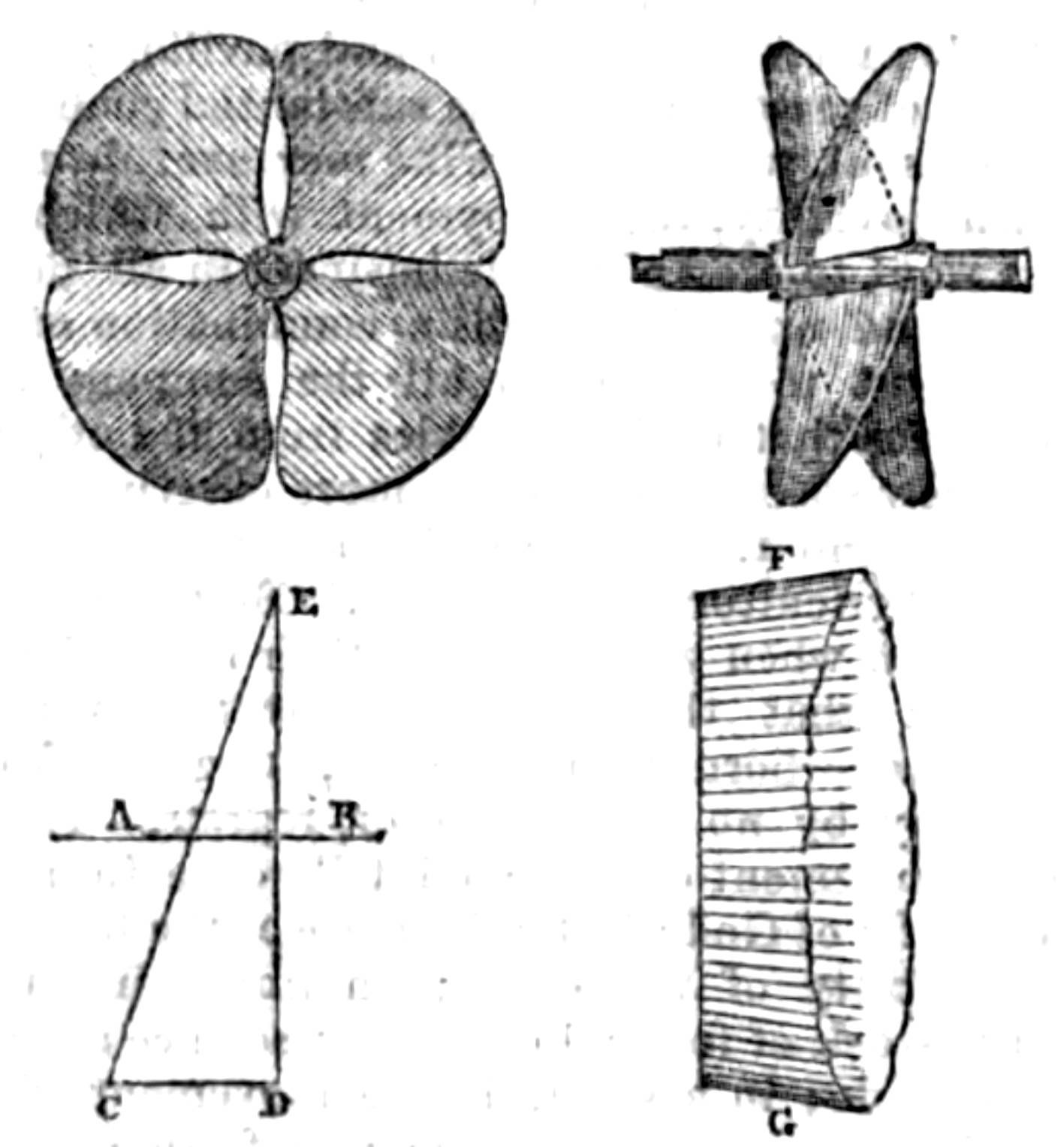
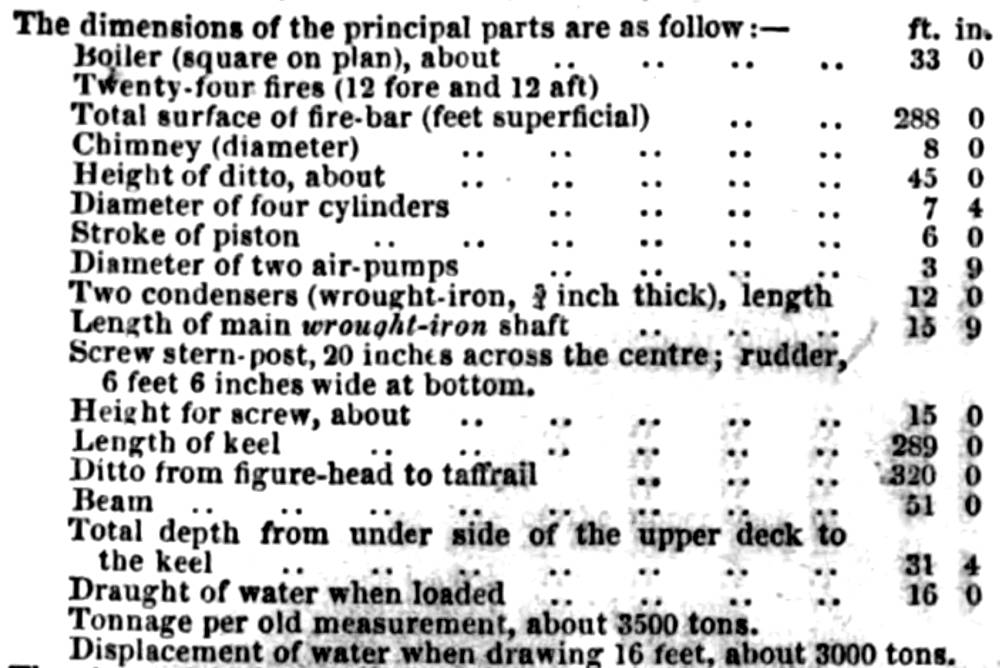
Left: The Screw of the Great Britain. Right: Dimensions of Principal parts of the Ship.
The plates of the keel are from ¾ inch thick in the middle to 1 inch at the ends; and all the plates under water are from 5-8ths to ½ inch at the top, except the upper plate which is 5-8ths. She is clencher-built, and double riveted throughout. Towards the extremities, and quite aloft, the thicknesses are reduced gradually to 7-l6ths.
The ribs are framed of angle iron, 6 inches by 3½, by half inch thick at the bottom of the vessel, and 7-l6tha thick at the top. The boiler platform is of plate-iron, supported upon ten iron kelsons, of which the centre ones are 3 feet 3 inches deep. The kebons are formed like the floorings, of iron plates placed on edge. The hull is divided into flve distinct compartments, by means of substantial water-tight iron bulkheads. The decks, which are of wood, consist of the cargo deck, two cabin decks, and the upper deck.
From tbe keel being mentioned as above, it would probably be inferred by most readers that it has an external projecting keel, similar to a timber-built ship, but such is not the case. The only external projection along the midships is the edges of the central plate, which lies horizontally, and to each edge of which the first rows of plates, forming the hull, are riveted. The ends of the central keel-plates are formed into long scarf joints and well riveted, and the first two or three longitudinal rows of plates have their 1aps, or external projecting edges pointing upwards, or clencher-build inverted, and above this the edges are downwards, in the ordinary manner, both of which methods appear to be based on scientific reasons.
At the engine room, for the purpose of giving greater strength than appears was originally intended, there are nine new additional intermediate double ribs introduced, and sixteen additional reverse ribs riveted tot he orginal framing. She is not double-riveted through9out, but in the longitudinal laps only.
Steam power of engines ................. .. 1000 horses.
Stowage for coals .............................1100 tons.
Will accommodate .................. 360 passengers.
Dining accommodation for.................... 380 ditto.
Crew will consist of........................... 130 persons.
There are to be six masts, on which will, it it said, be spread 1700 square yards of canvass when all set, which is only about it 9-10ths of that of a 46 gun frigate; while the lengti of the upper deck of the Great Britain is about 2 1-7th times, and deck surface 2 ½ times as much as the above-named frigate though probably the area of the midship transverse section at the load line is very little more in the Great Britain than in that of the frigate. The displacement of the frigate fitted and fully equipped for foreign service, is not quite half that given of the Great Britain, which it rather more than a loaded 74.
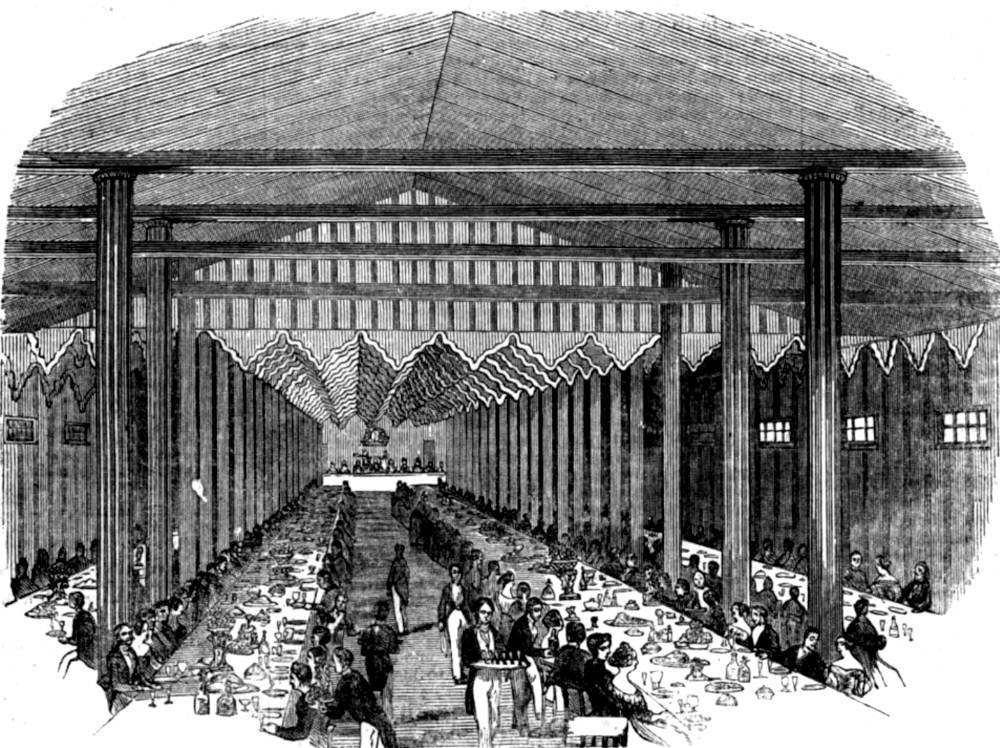
Breakfast on board the Great Britain
The mould-lines of the Great Britain, and of her general construction, as well as the minutiae and details of minor parts, appeared to he in beautiful proportions and harmony; and considering the materials used ip construction, having to provide capacity and strength for powerful engines, and a form the most suitable for stem propulsion, as also to attain great speed, and other consequent circumstances, the symmetry and gracefulness reflect the greatest credit on the nautical draughtsman for having given the lines of construction for as elegant a piece of marine architecture as can be found in any part of the globe. At the same time Mr. Hill does not cousider that this eulogium applies to the flatness of the sides from the engines for a considerable distance upwards, but thinks it probable that such a departure from a more graceful curve may have been decided on from an idea that the flatness (which appears a defect) may be the more efficacious in preventing rolling in a heavy sea, provided the centre of gravity of the whole mass, when equipped for a voyage, should be found to be in a favourable position. The entrance from tne “fore foot” upwards is very fine, and calculated to displace the water easily, and the “run” very thin. The whole of the materials and workmanship, both of ship and machinery, appear to be of the first order.
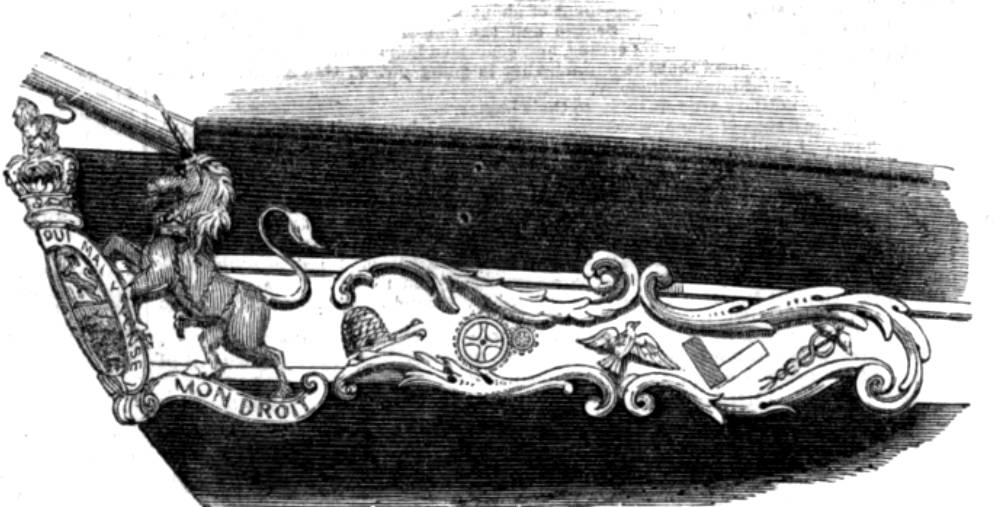
Figurehead of the Great Britain.
The advocated dogma of “cod’s-head and mackerel tail ” of former days in ship building appears to be paased away. Ceitainly nothing remains of the cod’s head, and but little of the mackerel tail, in the Great Britain. A fulness in the midahips, for the peculiar construction of engine, wai necessary ; from this to the extreme point of the bows aeems admirably adapted for cutting the waves and going easily through the water, and probably The advocated dogma of “cod’s-head and mackerel tail” of former days in ship building appears to be passed away. Ceitsinly nothing remains of the cod's head, and but little of the mackerel tail, in the Great Britain. A fulness in the midships, for the peculiar construction of engine, was necessary; from this to the extreme point of the bows seems admirably adapted for cutting the waves and going easdy through the water, and probably approaches as near the figure of “least resistance” as possible, while, at the same time, a consideration of the vertical sections forwaid will show that there is little to be apprehended of its being a “ ship.” The bulk of displacement being greatest about the centre of gravity of the vessel, there will necessarily he much less disturbance by the waves, and a shorter voyage thereby to New York than by the “full bow,” though in the same track.
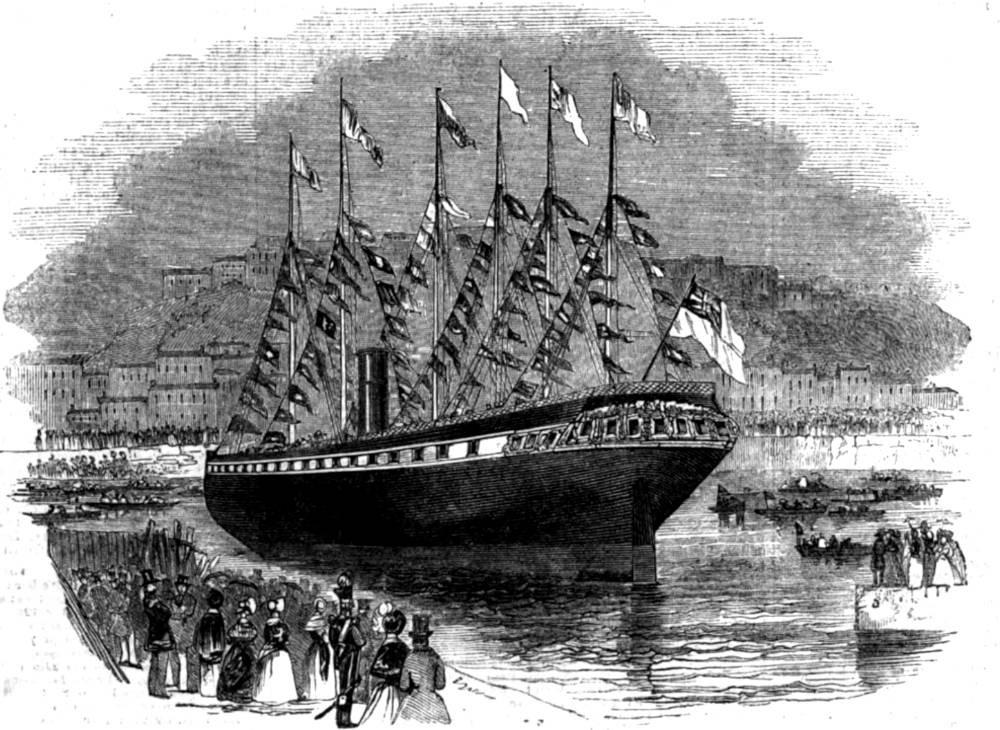
The Great Britain
The beams or joists for the support of the several decks, are bars of apparently 3-inch angle iron, with a joist bar of 5 x ½ inches riveted on the side—distance generally of the joists from 2 feet 4 inches to 3 feet. The deck planks are fastened to the angle iron by screws from below. To provide against the possibility of the entire structure springing or bending horizontally, there is placed between the angle iron bars and deck planks a series of diagonal flat tension bars, forming a continuous horizontal truss from end to end in each principal deck, riveted to the angle irons at the crossings and at the ends.
The Machinery.— The boiler presents a great quantity of surface to the action of the fire and heated air, and appears amply strong for condensing engines.
The Engines approach the patent plan of Sir Mark Brunel, at least in the position of the cylinders, except that instead of the cylinders making a right augle, or 90 degrees with each other, they stand at an angle of 60 degrees, or thereabouts.
The most extraordinary part of fhe whole machinery, and more particularly deserving of notice than any other, is the wrought iron main shaft made at the Mersey Iron Works, Liverpool. The whole of the work appears extremely well executed, the details to have been considered with great care and judgment, and the proportions, with some exceptions, are well maintained. When finished, and set to work, Mr. Hill has no doubt they will prove good engines.
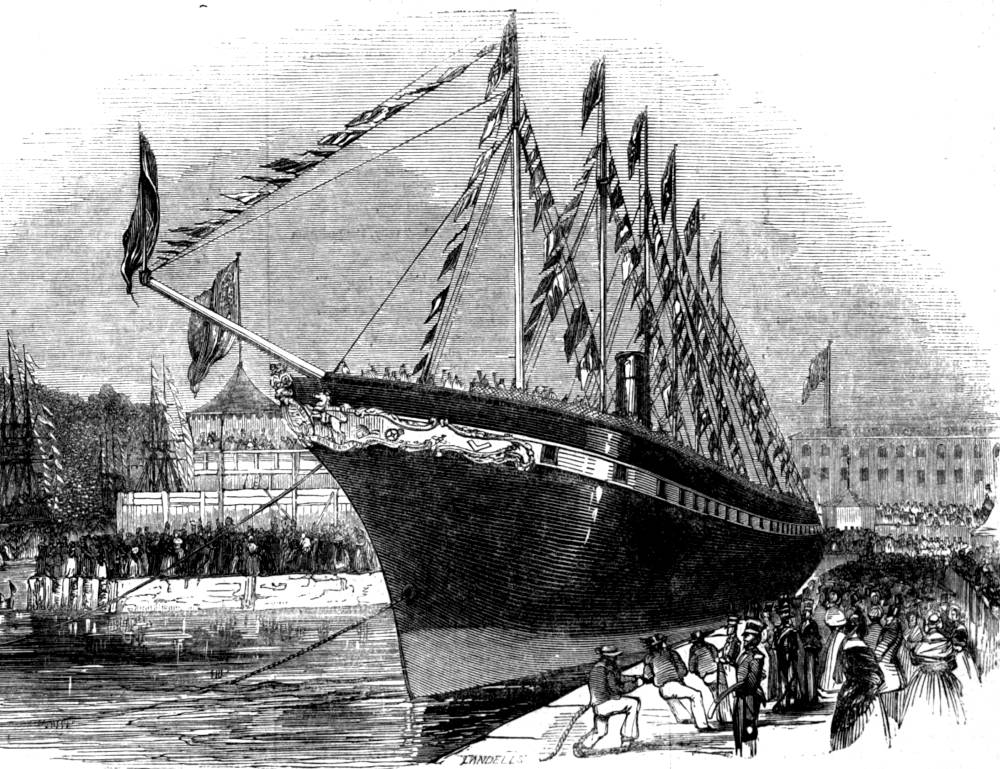
Launch of the Great Britain
And “last, though not least,” but by far the greatest, comes the screw. In order that a vessel may be propelled ten miles an bour by the screw, it is found that the progressive velocity of tbe screw must be twelve miles an hour, or one-fifth forward faster than the vessel; and supposing such to be correct, or thereabouts, and that the screw makes 80 revolutions per minute, the pitch of the screw (or, perhaps, the base of the inclined plane will be an expression as well suited) must be (5280 x 12 [divided by] 60 x 80)= 13 feet 2 inches, whether it be a complete one entire thread, similar to the first Archimedes, two half-threads, similar to the present Archimedes (which is 6 feet diameter by 5 feet long each), or similar to tbe Great Britain model, and shown in figs. 1 and 2, Still it but slightly affects the present inquiry. Allowing the diameter of the Great Britain screw to be 15 feet, the diameter of the circle of effect would be about 12 feet 6 inches, or 39 feet 6 inches circumference; therefore tbe mechanical constructions, if developed to a straight wedge would be represented by A B, fig. 3, line of axis; C D, distance passed over by one revolution (13 feet 2 inches); D E, circumference of circle of total effect; and C E, acting face of the screw. The amount of resistance caused by the friction or adhesion of the water on the face of the screw will very much depend on the smoothness of the surface; or, probably, a thin disc of water will be carried round with the screw, aud tbe friction take place amongst tbe particles of water at some slight distance from the face. F G, fig. 4, shows the divergent lines of the cone of motion communicated to the water; and, if the above premises be correct, it appears to promise a greater effect than has generally been expected, inasmuch as the direction of impact of the screw does not make so great an angle from the line of the axis.
The Great Britain has been constructed in a dock excavation. The bottom of this dock is twelve feet below the surface of the water in the harbour, and, as her bottom stands a working height above the bottom of the dock, it is purposed to pump water to a higher level than the harbour, so as to remove the supports and allow her to drop and to be floated out.
Taking all circumstances into consideration, it does appear that if by the use of an equal weight of fuel the “duty” performance of the screw be nearly equal to that of the paddle-wheel, and that the whole of the machinery be so constructed as to he lasting, and not unpleasant to passengers, it has the merit of being free from some serious inconveniences of the paddle-wheel, such as great topheaviness, opposition of the paddle-boxes to the wind, &c., and possesses these advantages besides, namely, that strength in the upper part of the ship is not required to support machinery, and that the deck is clear—a great comfort to passengers, and of great convenience in management of sails and wording the ship.
It is the intention of the directors to use wire standing rigging, which appears admirably adapted for the purpose from its being less in size, and therefore presenting less surface when under “bare poles,” from its being lighter than rope, strength for strength, from its greater durability; for if oxydation be prevented there seems no limit to it, and from its maintaining nearly a permanent length, and not requiring frequent “setting up,” as is the case with rope; and probably it is more particularly applicable to iron vessels than wooden ones, from the rigidity ot the former not requiring the elasticity that may be serviceable in the latter.
We should add, that Mr. Hill's entire description of this steam leviathan fills a whole sheet ot the Mechanics’ Magazine, So. 990.
Related Material
- The Early History of the Steamship
- The Screw Steamship "Great Britain"
- Brunel's Great Britain, one of the most important steam ships ever built
[You may use the images above without prior permission for any scholarly or educational purpose as long as you (1) credit the Hathi Trust and the University of Chicago. (2) link your document to this URL in a web document or cite the Victorian Web in a print one.]
Bibliography
“The Great Britain Steam-Ship.” Illustrated London News 2 (1843): 34 Hathi Trust online version of a copy of the Illustrated London News in the University of Chicago Library. Web. 14 June 2021.
“Launch of the Great Britain Steam-Ship.” Illustrated London News 3 (1843): 72-74 Hathi Trust online version of a copy of the Illustrated London News in the University of Chicago Library. Web. 1y June 2021.
Last modified 17 June 2021